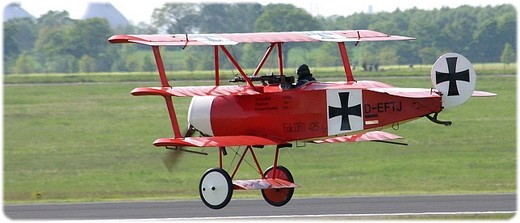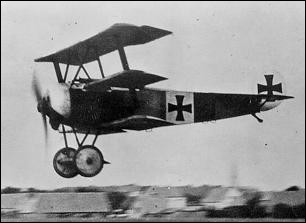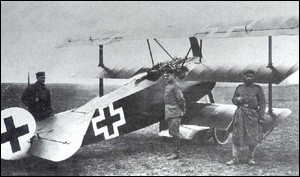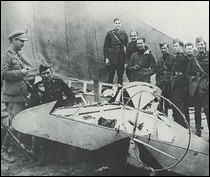 |
Fokker Dr. 1
Fokker Dreidecker 1 is that little red triple-winged airplane that for many of us represents dogfights over the Western Front trenches during World War 1. Dr. 1 entered service late in the war but quickly became both popular and feared, not least for its superior manoeuvrability. But it also had some serious constructional flaws, which led to several crashes.
 |
| Early morning on the Western Front in 1918. A flight of Fokker Dr. 1 of Jasta (Jaktstaffel) 15 is preparing for take-off. |
[ Top of page ]
History
When the British Sopwith Triplane was introduced in April 1917 it soon became clear that it was superior to any of the German fighters at the time. Idflieg - Inspektion der Fliegertruppen - immediately requested manufacturers to design a new triple-winged aircraft. No fewer than 11 of them did, including Fokker, Albatross, Pfalz and AEG. After some failed tests and problems with steering and control surfaces in V.3, Fokker-Flugzeugwerke presented the reworked V.4. Following a flight test that proved the Fokker V.4 to be the best prototype, Idflieg issued an order for immediate start of production.
 |
Flight test of Dr. 1, serial number 101/17, at Fokker-Flugzeugwerke in Schwerin-Gorries, August 1917. |
The Dr. 1 could fly like no other airplane before. It looped and rolled with ease, much thanks to its built-in instability, and it could out dive and climb away from an enemy with secure manoeuvring. But eventually a major flaw became apparent: It was too slow. It could neither catch up nor run away from an adversary, and performance suffered at high altitude. And when there was a shortage in castor oil and the German substitute turned out to be no good, many engine failures resulted in the summer of 1918.
After some strange accidents where aircraft broke up in flight, all Dr. 1 were grounded pending an inquiry. It revealed bad production routines that caused the wings to become weakened from moisture. Fokker improved control on the production line, after which the Dr. 1 was allowed to fly again, but the accidents continued. After the war it was discovered that there was also a constructional flaw: the upper wing had carried a much greater load than the lower, at high speeds up to 2.5 times as much.
When the war ended the Versailles treaty demanded the destruction of all Dr. 1 aircraft, and this demand was met. No original aircraft of the 320 manufactured are around today, but there are flying replicas of this classic aircraft to be seen.
[ Top of Page ]
Red Baron
This exhibition is about aircraft and not so much about pilots, but in this case an exception to the rule is motivated. Not many aircraft are so associated with one single pilot as the Fokker Dr. 1.
Manfred Albrecht Freiherr von Richthofen - the Red Baron - was the aristocrat who became the most celebrated flying ace of World War 1, with 80 confirmed enemy aircraft shot down. He used many different aircraft and only 20 of his victories were scored flying the Dr. 1.
 |
 |
| Manfred von Richthofen's Dr. 1. At left just before the final flight. At right Australian soldiers are inspecting the remains. The aircraft was fairly intact after ditching but was soon taken apart by souvenir hunters. | |
He was decorated and treated a national hero, and was used extensively for propaganda purposes as the immortal soldier, leading Jasta 11 from his red aircraft. He died just after 11 a.m. on April 21, 1918, while flying over Morlancourt near the river Somme. After chasing a Sopwith Camel at low altitude, everything suggests that he was hit by a single bullet from the ground. He managed to make an emergency landing, but died before the Australian Imperial Force soldiers controlling the area could reach the site.
[ Top of page ]
Video
| A newly built replica of a Fokker Dr. 1 and a Sopwith Camel. Note the pilot's Isadora Duncan-ish scarf. Not much to be done about the babbling speaker, I'm afraid... | |
[ Top of page ]